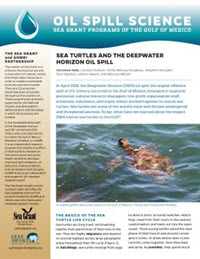In April 2010, the Deepwater Horizon (DWH) oil spill, the largest offshore spill in U.S. history, occurred in the Gulf of Mexico. Emergency response personnel, natural resource managers, non-profit organization staff, scientists, volunteers, and many others worked together to rescue sea turtles. Sea turtles are some of the world’s most well-known endangered and threatened animals. So far, what have we learned about the impact DWH had on sea turtles in the Gulf?
THE BASICS OF THE SEA TURTLE LIFE CYCLE
Sea turtles are long-lived, air-breathing reptiles that spend most of their lives in the sea. They are highly migratory and depend on several habitats across large geographic areas throughout their life cycle. As hatchlings, sea turtles emerge from eggs located in nests on sandy beaches. Hatchlings crawl from their nests to the nearest coastal waters and swim out into the open ocean. These young turtles spend the next phase of their lives in and around convergence zones, or areas where open ocean currents come together. Here they feed and grow. As juveniles, they spend much of their time at or near the ocean surface. Click the link below for more…
This work was made possible in part by a grant from The Gulf of Mexico Research Initiative, and in part by the Sea Grant programs of Texas, Louisiana, Florida and Mississippi-Alabama. The statements, findings, conclusions and recommendations do not necessarily reflect the views of these organizations.

